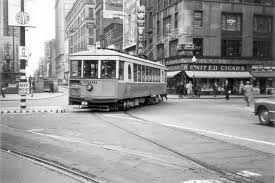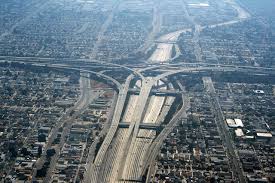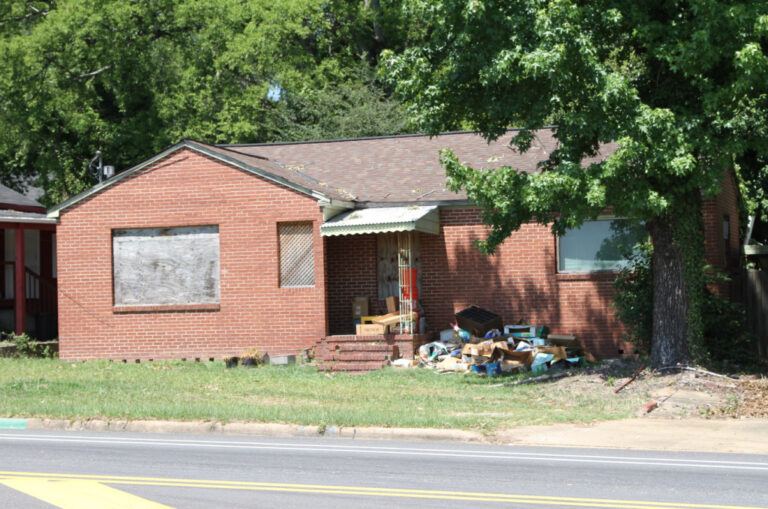Physical Address
304 North Cardinal St.
Dorchester Center, MA 02124
Physical Address
304 North Cardinal St.
Dorchester Center, MA 02124

This is the first article of a five-part series on suburbia in the United States. In primary school, one of my friends lived in a duplex. This fact blew my mind. To my inexperienced 7-year-old mind, a duplex barely registered as a house. Her family shared a driveway with their neighbors, and their yard was tiny. It was the first house I’d ever seen that shared a wall with its neighbors. I’d seen apartments of course, but in my mind those were temporary, for people who who were saving up to buy a “real” home. I couldn’t understand that some people might actually prefer to live in something besides a private home, because I’d never come across it before. Median income in American cities tends to rise at about 8 percent per mile as one moves away from the business district. My mental model of the world was pretty typical for an American child brought up in a single-family home. It’s easy to see why—US residential development is dominated by suburbs, and home ownership is touted as the ultimate symbol of prosperity. Other types of dwellings tend to be for young people starting out in life or low income households unable to afford a place of their own. The popular image of the American Dream includes a white picket fence and a car, not an apartment and a subway pass. This is in stark contrast with most other countries. The French word for suburb is banlieue, and it has come to connote poverty and social isolation, because that is where immigrants and the poor tend to live. They’ve been known as “red suburbs” because of their tendency to vote Communist. Meanwhile, the wealthy live in the city center. In South Africa, the inner city is reserved for the privileged white […]

I am happy to announce that my new book “Government Intervention and Suburban Sprawl: The Case for Market Urbanism” is now available at Amazon. There is a “look inside the book” feature at the book’s Amazon webpage for those who would like to know more. I would like to thank not just the readers of this blog who commented on drafts, but also on those of you who helped me refine my thinking by commenting on blog posts.

The economist F.A. Hayek explained why it’s impossible for human reason to successfully design complex systems such as markets or language. One can’t simply say, “Hey, I’d like to invent a Germanic language that does away with those troublesome genders and inflections but has plenty of Latin- and Greek-based words sprinkled in.” That would be English, of course, which evolved over centuries of trial and error. (Some might want to use Esperanto as a counterexample, but let’s face it: There are probably more people today who can speak Latin, a dead language, than can speak Esperanto.) The current fashion to construct mass-transit infrastructure in places, such as Phoenix, where none had existed before is like this in a certain sense. As Hayek explained, the problem is that reason, while powerful and creative, is imperfect and extremely limited compared to the complexity and open-endedness of the social world. As a result, all actions will have unintended consequences. The trick is to find “rules of the game” – such as private property and norms of reciprocity – that over time generate consequences that correct errors and promote rather than prevent social cooperation. While economists and social theorists since Adam Smith have understood this, many in the urban-planning profession don’t seem to have fully grasped the message. When Sprawl Was Good Since at least the 1970s in the United States the idea has been to try as much as possible to substitute mass-transit for the private car. To New Urbanists, for example, that is the key to solving a host of social ills including pollution, overcrowding, racial discrimination, oil-dependency, and alienation – all allegedly connected to the phenomenon of “sprawl.” (See, for example, the Charter of the New Urbanism.) I’ve been rereading Robert Bruegmann’s excellent book, Sprawl: A Compact History, in which he […]
Because of work obligations, I listened to only about a third of today’s Cato Institute discussion on urban sprawl. I heard some of Randall O’Toole’s talk and some of the question-and-answer period. O’Toole said high housing prices don’t correlate with “zoning” just with “growth constraints.” But the cities with strict regionwide growth constraints aren’t necessarily high cost cities like New York and Boston, but mid-size, moderately expensive regions like Seattle and Portland. He says that if land use rules raise housing prices they violate the Fair Housing Act. Maybe this should be the case, but it isn’t. Government can still regulate in ways that raise housing prices, but just have to show reasonable justification for those policies under “disparate impact” doctrine. He also says cities would be less dense without zoning. Is he aware that most city regulations limit density rather than mandating density? O’Toole says growth constraints are why American home ownership rates are lower than in Third World countries and that the natural rate of home ownership is 75 percent. But why are home ownership rates so low in sprawling Sun Belt cities? For example, metro Houston’s home ownership rate is about 59 percent – higher than New York or San Francisco, but lower than Philadelphia or Pittsburgh. The highest home ownership rates are in Rust Belt regions like Akron, I suspect because of low levels of mobility. Some things he gets right: 1) public participation in land use process is harmful because it leads to more restrictions, not less; (2) the mortgage interest deduction doesn’t make much difference in home ownership rates.

Also read my other post about Kotkin’s book: NIMBYism as an Argument Against Urbanism Traditionally, defenders of suburban sprawl have been skittish about proclaiming that government should promote sprawl and halt infill development. Instead, they have taken a libertarian tack, arguing that government should allow any kind of development while asserting that a level playing field would favor automobile-dependent suburbia. But in his new book The Human City, Joel Kotkin, who, among many other titles, is the executive director of a pro-sprawl organization called the Center for Opportunity Urbanism, appears to take a different view. Like more libertarian defenders of the status quo, he generally opposes attempts to limit new suburban development. But he also writes that both city residents and suburbanites aggressively resist “densification”- that is, when nearby landowners want to build new housing or offices. For example, he writes that Los Angeles neighborhood activists “have rallied against attempts to build denser buildings, which generate more congestion and erode both the area’s livability and its distinct urban identity.” Similarly, he writes that some New Yorkers opposed “Mayor Bloomberg’s attempts to further densify already congested Midtown.” But Kotkin never suggests that turning a cornfield into a subdivision creates congestion, or that doing so would erode an area’s “distinct rural identity.” He also doesn’t seem to think that new housing belongs in existing suburbs: in describing zoning that prohibits such housing, he writes that “suburbs generally can be expected to, for the most part, resist high degrees of densification”, including “attempts by planners to impose strict regulations on construction and impose higher densities”. This language implies (erroneously) that “densification” is something imposed by a distant government, rather than by landowners who want to build places for people to live. So if I interpret his book correctly, it seems that there is nothing libertarian […]

Suburbs have been around for as long as there have been urbs – cities, that is – a fact Robert Bruegmann reminds us of in his excellent book Sprawl. And as sociologist Max Weber in The City and historian Henri Pirenne in Medieval Cities remind us, it’s often in the younger, freer suburbs rather than the older, more-conservative central city where entrepreneurial energy is unleashed. The difference today perhaps is that the epithet “sprawl” has been attached to this sort of outward, penumbral development, which, especially in the United States, has taken place very rapidly since World War II. Stripping it of its negative connotations, Bruegmann defines sprawl as “low density, scattered, urban development without systematic large-scale or regional public land-use planning.” A Sprawling Debate There has been a lot of Internet chatter lately about what libertarians ought to think about urban sprawl and its causes, including pieces by Kevin Carson, Austin Bramwell, Randal O’Toole, and Matthew Yglesias. The title of Ben Adler’s post basically sums it up: “If You Love the Free Market, You Should Hate Mandated Suburban Sprawl.” All seems to be centered on O’Toole’s recent comments on John Stossel’s program on Fox Business, which evidently defended urban sprawl against advocates of so-called “Smart Growth,” government policies intended to combat sprawl and its alleged bad consequences. I have not yet seen the show myself, so I’m really just responding here to the interesting reactions it has provoked. (I will perhaps explore the issue of whether sprawl is a good thing or a bad thing in another column.) On the one side are those, such as O’Toole, who hold that suburban sprawl is chiefly a free-market phenomenon and therefore an expression of consumer demand, and on the other are those, such as Yglesias and myself, who look at the […]

I keep up with the reports and journalists proclaiming that America’s suburbs are thriving and will continue to do so forever. Yet I keep scratching my head since these depictions are in conflict with what I keep seeing on the ground as I travel around the country. The folks who declare the permanent triumph of suburbia must live in the prosperous enclaves near the lake and golf course, not the poorly aging subdivisions that are rapidly losing value and becoming reservoirs for the downwardly mobile former middle class. There’s absolutely nothing wrong with any of these homes, but here they are boarded up as the entire neighborhood slowly slides into decline. If the 1950’s subdivisions are looking dogeared you should check out the older neighborhoods from the early twentieth century. They’ve been neglected even longer and the collective deferred maintenance shows. I checked the real estate listings in this Georgia town and many of these homes can be bought for as little as $20,000. The average price seems to be closer to $40,000 or $50,000. Here’s one of the problems. This town has enjoyed a suburban building boom for the last few decades. These new homes are part of one of the better new communities being built on the far edge of town. These are desirable places to live and people who can afford to move here do so. Homes here are offered for between $350,000 and $500,000. But this region has a steady population. The number of people in the area has been increasing very slowly even as the number of new homes and commercial buildings continues to ramp up at a heady pace. There’s a direct connection between the impoverishment of the empty homes in the older parts of town and these new developments way out on the […]

Inclusionary Zoning is an Oxymoron The term “Inclusionary Zoning” gives a nod to the fact that zoning is inherently exclusionary, but pretends to be somehow different. Given that, by definition, zoning is exclusionary, Inclusionary Zoning completely within the exclusionary paradigm is synonymous with Inclusionary Exclusion. What is Inclusionary Zoning? “Inclusionary Zoning” is a policy requiring a certain percentage of units in new developments to be affordable to certain income groups. Sometimes, this includes a slight loosening of restrictions on the overall scale of the development, but rarely enough loosening to overcome the burden of subsidizing units. Many cities, particularly the most expensive ones, have adopted Inclusionary Zoning as a strategy intended to improve housing affordability. Often, demand for below-market units are so high, one must literally win a lottery to obtain a developer-subsidized unit. Economics of Exclusion We must first acknowledge the purpose of zoning is to EXCLUDE certain people and/or businesses from an area. Zoning does this by limiting how buildings are used within a district, as well as limiting the scale of buildings . These restriction cap the supply of built real estate space in an area. As we know from microeconomics, when rising demand runs into this artificially created upward limit on supply, prices rise to make up the difference. As every district in a region competes to be more exclusive than its neighbors through the abuse of zoning, regional prices rise in the aggregate. Since the invention of the automobile, and subsequent government overspending on highways, sprawl has served as the relief valve. We’ve built out instead of up for the last several decades and this sprawl has relieved some of the pressure major metropolitan areas would have otherwise felt. In fact, it’s worked so well–and led to the abuse of zoning rules for such a long time–that exclusionary zoning has become the accepted paradigm. Zoning is the default flavor of […]

LA rent sucks. It’s way, way too damn high. Let’s fix it. If you rent, you’re probably already on board. You gotta pay the man on the 1st of the month, every month, and that sucks. But what if you are the man? You’ve got the sweet house, the trophy husband, the picket fence. Even then, you should still be upset. Here’s why this matters, to everybody: High housing costs are hamstringing the whole American economy. To the tune of a TRILLION dollars a year. $3,000 for every man, woman, and child. Short and sweet – the places where the rents are too damn high tend to be places where people are more productive and can make a lot of money (think entertainment in LA, tech in SF, or finance in NYC). But because the cost of living is so high in those places, lots of people choose to move to places where it is cheap instead. If we drove rents down, and people started moving to where the best jobs are, the US economy would grow by $1-2 trillion a year. That’s more money for you, more money for me, and more money for Uncle Sam. High rents are trapping us in our cars, breaking up families, and literally driving us into obesity and early death. Remember those high-paying jobs in our most productive cities? Well some people want them even though they can’t afford to live near them. So they drive, and they drive far. And when more people drive, and the farther we drive, the more cars there are on the road (cars on road = # of people driving x distance they drive). Then we’re all stuck in traffic. Sitting in our damn cars for hours in traffic makes us fat, gives us less time at […]
About a month ago, I wrote about the pros and cons of school vouchers as a solution for “school-based sprawl” (that is, parents moving to suburbs to avoid urban public schools). I noted that a voucher program that included private schools might be expensive, since some private schools are quite costly. By contrast, a school choice program limited to public schools would avoid these fiscal problems: the state could simply forbid public school districts from discriminating on the basis of residence. If a school district wanted to avoid radical increases in enrollment, it would have to use a lottery to decide which students were admitted. This plan might discourage sprawl by making prestigious suburban schools available to urban parents. And if both students from affluent families and students from poor families entered these schools, the class differences between urban and suburban schools might be erased in the long run. So such an open enrollment program might both expand student choice and be more egalitarian than the status quo. This plan has one major cost: it would require a considerable investment (either public or private) in transportation, since students in search of good schools might wish to go all over a metropolitan area. Either government will have to buy many more school buses, or parents will have to spend a lot more time transporting their children to faraway schools. Moreover, suburbanites will be unwilling to pay property taxes for schools that other people’s children will attend; thus, states might have to take over school financing. I note that most states have in fact enacted “open enrollment” laws allowing some interdistrict transfers. However, these laws are generally toothless; suburban school districts can generally refuse to admit students from other districts on the ground that there is insufficient space for them. Moreover, open enrollment […]